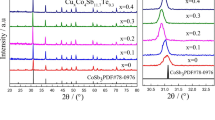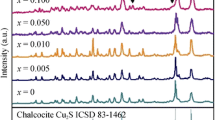Abstract
Metal chalcogenides especially Cu2−x Se has gained much attention in thermoelectric community due to its complex crystal structure and superionic behavior. Here, we report a facile method to improve the thermoelectric efficiency by introducing ZnTe nanoinclusions into the matrix of Cu2−x Se. As a result, a substantial improvement of 32% in electrical conductivity of Cu2−x Se-ZnTe composite is observed. The increase in electrical conductivity is at the expense of Seebeck coefficient, which slightly decreases the power factor of the composite samples than that of pure Cu2−x Se. Furthermore, the introduction of secondary phase facilitates in declining the total thermal conductivity of Cu2−x Se-ZnTe composite up to 34% by suppressing the lattice thermal contributions. Thus, the moderate power factor and lower thermal conductivity values result in an improved figure of merit (zT) value of ∼0.40 in mid-range temperature (750 K) for Cu2−x Se-ZnTe composite with 10 wt.% of ZnTe, which is about 40% higher than that of its pure counterpart. Hence, it is believed that the incorporation of ZnTe nanoinclusions in the matrix of Cu2−x Se may be an important route to improve the thermoelectric properties of Cu2−x Se based compounds.
摘要
由于具有复杂的晶体结构和超离子导体行为, 金属硫属化合物特别是Cu2−x Se在热电领域得到了广泛的关注. 本文报道了一种简单易行的提高热电效率的方法:在基体材料Cu2−x Se中添加纳米ZnTe插层, 用来提高Cu2−x Se材料的热电性能. 实验结果表明, Cu2−x Se-ZnTe复合材料的电导率提高了32%, 电导率的增加牺牲了塞贝克系数, 导致复合材料的功率因子稍微低于纯Cu2−x Se基体材料; 第二相的引入抑制了晶格热扩散, 使得Cu2−x Se-ZnTe复合材料的热导率降低了34%. 由此可知, 适中的功率因子和较低的热导率致使含有10 wt.%ZnTe的Cu2−x Se-ZnTe复合材料在中温条件(750 K)下的zT值提高至0.40, 相比于纯Cu2−x Se基体材料该数值提高了40%. 因此, 向Cu2−x Se材料中添加纳米ZnTe插层, 是提高Cu2−x Se基材料热电性能的一个有效途径.
Similar content being viewed by others
References
Dresselhaus MS, Chen G, Tang MY, et al. New directions for low-dimensional thermoelectric materials. Adv Mater, 2007, 19: 1043–1053
Hochbaum AI, Chen R, Delgado RD, et al. Enhanced thermoelectric performance of rough silicon nanowires. Nature, 2008, 451: 163–167
Boukai AI, Bunimovich Y, Tahir-Kheli J, et al. Silicon nanowires as efficient thermoelectric materials. Nature, 2008, 451: 168–171
Butt S, Xu W, He WQ, et al. Enhancement of thermoelectric performance in Cd-doped Ca3Co4O9via spin entropy, defect chemistry and phonon scattering. J Mater Chem A, 2014, 2: 19479–19487
Butt S, Xu W, Farooq MU, et al. Enhancement of thermoelectric performance in hierarchical mesoscopic oxide composites of Ca3Co4O9 and La0.8Sr0.2CoO3. J Am Ceramic Soc, 2015, 4: 1230–1235
Vineis CJ, Shakouri A, Majumdar A, Kanatzidis MG. Nanostructured thermoelectrics: big efficiency gains from small features. Adv mater, 2010, 22: 3970–3980
Harman TC. Quantum dot superlattice thermoelectric materials and devices. Science, 2002, 297: 2229–2232
Venkatasubramanian R. Thin-film thermoelectric devices with high room-temperature figures of merit. Nature, 2001, 413: 597–602
Mitchell K, Ibers JA. Rare-earth transition-metal chalcogenides. Chem Rev, 2002, 102: 1929–1952
Kuropatwa B, Cui Y, Assoud A, Kleinke H. Crystal structure and physical properties of the new selenide-tellurides Ba3Cu17-x (Se, Te)11. Chem Mater, 2009, 21: 9906–9911
Li Y, Han Q, Kim TW, Shi W. Synthesis of wurtzite-zincblende Cu2ZnSnS4 and Cu2ZnSnSe4 nanocrystals: insight into the structural selection of quaternary and ternary compounds influenced by binary nuclei. Nanoscale, 2014, 6: 3777–3785
Ijjaali I, Mitchell K, Ibers JA. Preparation and structure of the light rare-earth copper selenides LnCuSe2 (Ln=La, Ce, Pr, Nd, Sm). J Solid State Chem, 2004, 177: 760–764
Yamamoto K, Kashida S. X-ray study of the average structures of Cu2Se and Cu1.8S in the room temperature and the high temperature phases. J Solid State Chem, 1991, 93: 202–211
Ballikaya S, Chi H, Salvador JR, Uher C. Thermoelectric properties of Ag-doped Cu2Se and Cu2Te. J Mater Chem A, 2013, 1: 12478–12484
Liu H, Shi X, Kirkham M, et al. Structure-transformation-induced abnormal thermoelectric properties in semiconductor copper selenide. Mater Lett, 2013, 93: 121–124
Zhao L, Wang X, Yun FF, et al. The effe cts of Te2- and I- substitutions on the electronic structures, thermoelectric performance, and hardness in melt-quenched highly dense Cu2-x Se. Adv Electronic Mater, 2015, 1: 1400015
He Y, Zhang T, Shi X, et al. High thermoelectric performance in copper telluride. NPG Asia Mater, 2015, 7: e210
Liu H, Yuan X, Lu P, et al. Ultrahigh thermoelectric performance by electron and phonon critical scattering in Cu2Se1-x Ix. Adv Mater, 2013, 25: 6607–6612
Li D, Qin XY, Liu YF, et al. Chemical synthesis of nanostructured Cu2Se with high thermoelectric performance. RSC Adv, 2014, 4: 8638–8644
Zhao L, Wang X, Wang J, et al. Superior intrinsic thermoelectric performance with zT of 1.8 in single-crystal and melt-quenched highly dense Cu2-x Se bulks. Sci Rep, 2015, 5: 7671
Gahtori B, Bathula S, Tyagi K, et al. Giant en hancement in thermoelectric performance of copper selenide by incorporation of different nanoscale dimensional defect features. Nano Energy, 2015, 13: 36–46
Biswas K, He J, Zhang Q, et al. Strained endotaxial nanostructures with high thermoelectric figure of merit. Nat Chem, 3: 160–166
Liu FS, Huang MJ, Gong ZN, et al. Enhancing the thermoelectric performance of ß-Cu2Se by incorporating SnSe. J Alloys Comp, 2015, 651: 648–654
Xu W, Liu Y, Chen B, et al. Nano-inclusions: a novel approach to tune the thermal conductivity of In2O3. Phys Chem Chem Phys, 2013, 15: 17595–17600
He Y, Lu P, Shi X, et al. Ultrahigh thermoelectric performance in mosaic crystals. Adv Mater, 2015, 2: 1–6
Jian X, Cao Y, Chen GZ, et al. High-purity Cu nanocrystal synthesis by a dynamic decomposition method. Nanoscale Res Lett, 2014, 9: 689
Yu B, Liu W, Chen S, et al. Thermoelectric properties of copper selenide with ordered selenium layer and disordered copper layer. Nano Energy, 2012, 1: 472–478
Bhaskar A, Pai YH, Wu WM, et al. Low ther mal conductivity and enhanced thermoelectric performance of nanostructured Al-doped ZnTe. Ceramics International, 2016, 42: 1070–1076
Cahill DG, Watson SK, Pohl RO. Lower limit to the thermal conductivity of disordered crystals. Phys Rev B, 1992, 46: 6131–6140
He Y, Day T, Zhang T, et al. High thermoelectric performance in non-toxic earth-abundant copper sulfide. Adv Mater, 2014, 26: 3974–3978
Xiao XX, Xie WJ, Tang XF, Zhang QJ. Phase tr ansition and high temperature thermoelectric properties of copper selenide Cu2-x Se (0 ≤ x ≤ 0.25). Chin Phys B, 2011, 20: 87201
Tyagi K, Gahtori B, Bathula S, et al. Enhanced thermoelectric performance of spark plasma sintered copper-deficient nanostructured copper selenide. J Phys Chem Solids, 2015, 81: 100–105
Author information
Authors and Affiliations
Corresponding authors
Additional information
Muhammad Umer Farooq obtained his BSc degree in computational physics from the University of the Punjab, Lahore and MSc degree in materials and surface engineering from the National University of Science and Technology (NUST) Islamabad. He joined the University of Science and Technology Beijing in 2012 where he is pursuing his PhD degree under the supervision of Prof. Kewei Gao. His research involves the synthesis of thermoelectric materials and their transport properties.
Nasir Mahmood obtained his BSc degree in 2009 in chemistry from the University of Punjab and MSc degree in 2011 in materials and surface engineering from the National University of Science and Technology, Pakistan. He got his PhD degree in materials science and engineering from Peking University in 2015 under the supervision of Prof. Yanglong Hou. Currently, he is working as a research fellow at the Institute for Superconducting and Electronic Materials, University of Wollongong. His research involves the synthesis of nanomaterials and their hybrid structures with graphene/carbon and their application in energy storage and conversion devices.
Rights and permissions
About this article
Cite this article
Farooq, M.U., Butt, S., Gao, K. et al. Pronounced effect of ZnTe nanoinclusions on thermoelectric properties of Cu2−x Se chalcogenides. Sci. China Mater. 59, 135–143 (2016). https://doi.org/10.1007/s40843-016-0126-x
Received:
Accepted:
Published:
Issue Date:
DOI: https://doi.org/10.1007/s40843-016-0126-x




